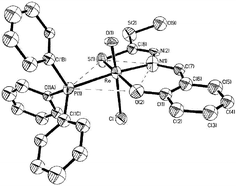Synthesis, properties and spectroscopic studies of rhenium(v) complexes stabilized by tridentate Schiff bases derived from S-methyl dithiocarbazate
Abstract
Neutral oxorhenium(V) complexes with tridentate SNO

* Corresponding authors
a
Ecole Nationale Supérieure de Chimie de Rennes, CNRS UMR 6052 “Synthèses et Activations de Biomolécules”, Institut de Chimie de Rennes, Avenue du Général Leclerc, 35700 Rennes, France
E-mail:
alain.roucoux@ensc-rennes.fr
Neutral oxorhenium(V) complexes with tridentate SNO

 Please wait while we load your content...
Something went wrong. Try again?
Please wait while we load your content...
Something went wrong. Try again?
F. Mévellec, A. Roucoux, N. Noiret and H. Patin, J. Chem. Soc., Dalton Trans., 2001, 3603 DOI: 10.1039/B109020H
To request permission to reproduce material from this article, please go to the Copyright Clearance Center request page.
If you are an author contributing to an RSC publication, you do not need to request permission provided correct acknowledgement is given.
If you are the author of this article, you do not need to request permission to reproduce figures and diagrams provided correct acknowledgement is given. If you want to reproduce the whole article in a third-party publication (excluding your thesis/dissertation for which permission is not required) please go to the Copyright Clearance Center request page.
Read more about how to correctly acknowledge RSC content.
 Fetching data from CrossRef.
Fetching data from CrossRef.
This may take some time to load.
Loading related content
